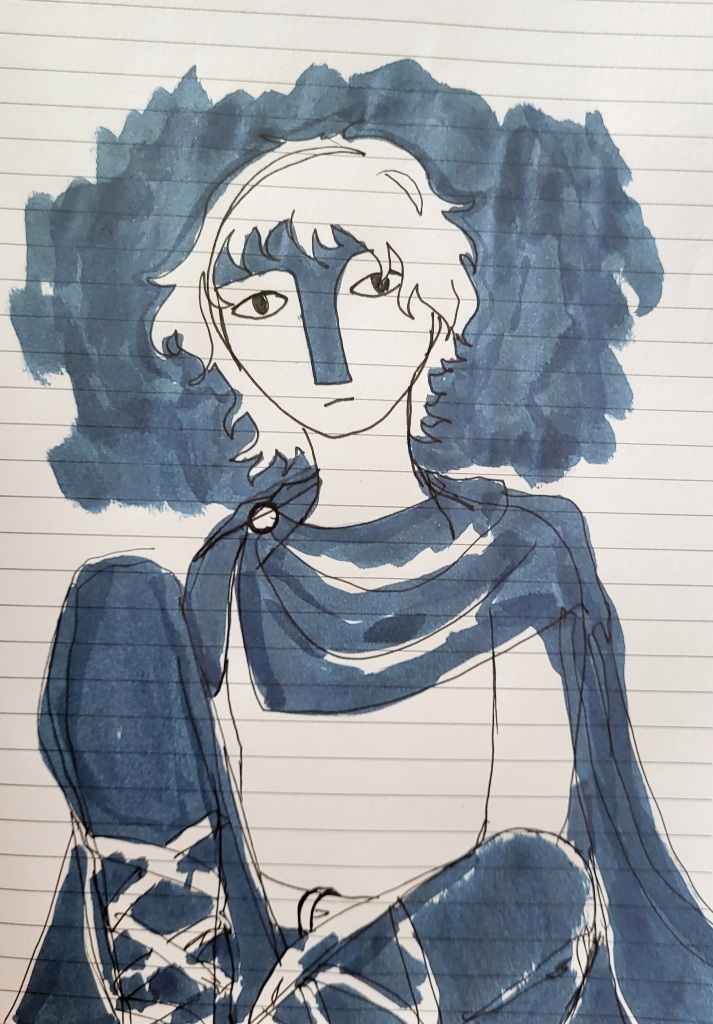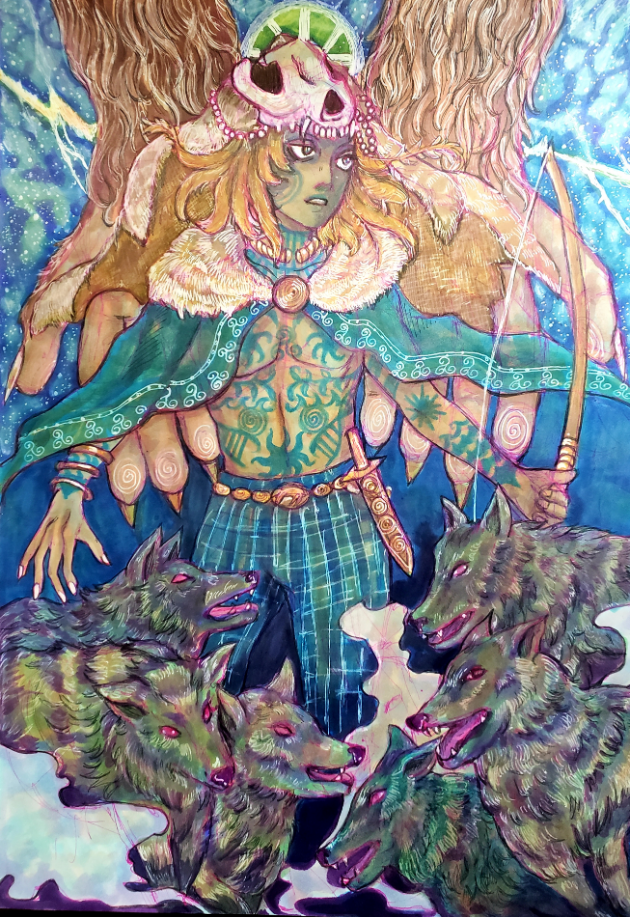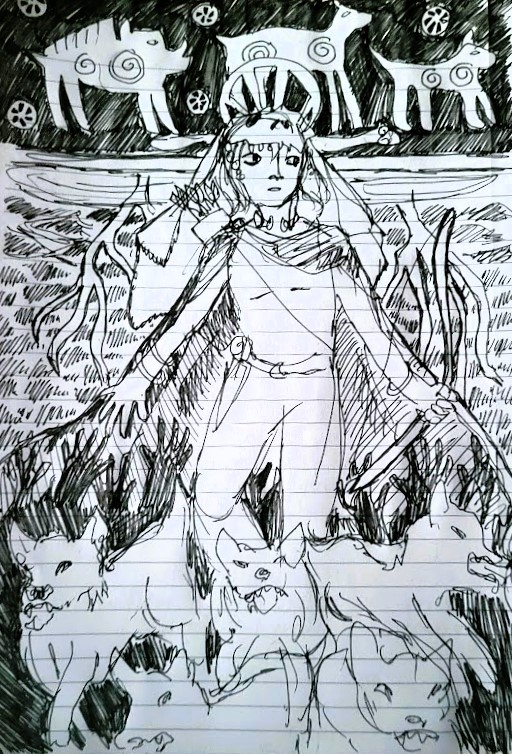
Description: A sketch of Maponos, who stands upright holding his lyre with an earnest expression. His hair is drawn to mimic flames, and his body is tattooed with leaves. In the centre of his chest is a four-spoked wheel reminiscent of the symbols on Celtic coins. The background is navy blue, save for harsh light surrounding his head like a halo.
Painting without painting
In the winter of 2010, I laid bare my Awen in a senior college class called Painting without Painting. The sharp-tongued professor had taken my comfort of the traditional canvas away from me and I wasn’t having it.
At this point however, I had accepted I just needed to pass to get my bachelors. My seizures and brain fog were out of control and most of the professors had been insidious about my declining technique and focus. I figured after this, painting was dead to me anyway. So I tried painting without painting.
I think it was probably my first time knowingly tapping into my Awen’s source and feeling the minerals in the water. I learnt how to evoke concepts by using other objects as the canvas, and was challenged to dive deeper into how space, form, and mediums can be used. In this class, I conjured a city from electrical sockets, created a forest around the 6th floor water fountain, and formed a dystopia of broken clocks.



Description: A sketch of Maponos seen in three different types of lighting, using black pen and navy blue ink. He sits with his legs partially crossed and wears a cloak pinned at his shoulders. His hair is short and fluffy. There is a dark, cloudy backdrop behind his head.
That professor also taught me that there is no such thing as a true blue. Only our perceptions of what blue is. I asked Maponos, have we as a species, ever tamed the colour blue?
He gave a gentle laugh and shook his head, “you cannot tame the monsters you create.”
Maponos and I have picked up where we left off last October, when we were pulling apart some trauma I had from art school. It means going back to a very difficult time in my life and trying to remember the helpful things I learnt. Such as how to paint without painting, which Maponos calls ‘colouring without colour’ for me.
He asks me questions such as;
What happens if I take those colours away?


Description: Cunomaglos is Lord of the Wolves, crowned with a wolf skull and pelt as he grips his hunting bow, staring off into the distance. At his feet wolves intermingle ferociously with mist, their fur dark and slick. In the backdrop are a pair of beastly, furry hands which frame his figure, as a storm rages on.


Description: Maponos, the Divine Son, curls into the fetal position dressed in leaves and with long hair made of clover blossoms. He is supported by two outstretched hands through which water runs down the canvas. At his feet are three masks, shrouded in dark cloths- the Matres. In the background, a gilded hunting procession with a boar, pig, deer, eagle, blackbird, and snake takes place.
Maponos presents me with the first two drawings I ever did of him and Cunomaglos. He has me analyze them. The drawings themselves were my tools of introduction, and remain my first impression of them both. A remnant of that energy. He asks me, however, if I think the energy of the piece changes without colour.
“I don’t know,” I say, “isn’t that up to the viewer?”
Maponos tells me ultimately I’m correct – though he wryly points out that I was evading his question.
This has me thinking about my professor said about no true blue existing. Perception of colour remains subjective, and must account for vision impairment or colourblindness. Maponos and I come to the agreement that someone with different vision capabilities than me should be able to perceive the energy I want to communicate- even if the colours are different.
Maponos’ first ‘colouring without colour’ lesson for me:
“I would like to see you try to recapture that energy [of those pieces] in black and white. And I want to see it in writing.”
I purvey that which needs not sight to see,
Maponos to me, from Infernals of Anagantios
For death removes your sharpest senses not
And colour is my dearest muse, says He
For colour is found in the warmth of rot
And moist fragrant mushroom caps, and fire-light
That burns the musk of green from spring hard-fought
Colouring without colour


Left image description: Cunomaglos is a divine huntsman, crowned by a wolf skull and pelt, as he holds his bow and gazes into the distance. His cloak is made of shadowy hands reaching up from the underworld. Crudely drawn white wolves lead his way, pressing forward in a relentless chase. They are his procession, his messengers. Everything around them is dark. Cunomaglos seems to be rising from the underworld even as the roots behind him, in sun-dappled waters, reach downward like claws. Accented in the upper third are animals- boar, stag, dog, and ram-horned snake. Everything around them is dark too, save the light of the wheels buried with them.
Right image description: Cunomaglos, the Hound Prince, races through a crowd of birch trees which stretch up to leafy canopies. He is crowned by a wolf skull and pelt. He holds his bow and gazes off into the distance, following his pack of white wolves who twist and turn ferociously at his feet. A mist surrounds Cunomaglos, who is flanked by the image of two pairs of hands making shadow puppet signs for dogs.


Left image description: Maponos is the Great Son, lying in the fetal position clutching his harp, with hair made of clover blossoms. At his left is a boar to represent the Twrch Trwyth. Behind him a pair of hands form the shadow puppet sign for a bird. He is surrounded by still waters, from which three oak trees grow and stretch their canopies to the top of the canvas. At his feet lay three shrouded masks- the Matres.
Right image description: Maponos as the Great Son lies in the centre, in a fetal position. His tunic is made of leaves and his hair of clover blossoms. Above him are three masks – the Matres – supporting a cloak which shrouds them. The cloak cascades downward and frames a background scene of still waters from which a great oak tree grows. Its canopy of leaves stretches far. At his feet, beneath the earth, is a hunting procession- a dog, stag, boar, and ram-horned snake move past. All is dark around them, save for the spoked wheels they are buried with.
Maponos, the God who sings in colour.
This all started when I was focusing too much on creating pieces that I could potentially sell prints of. I felt the pressure because I wasn’t working, that I had to be productive. But I’m not working because I’m having health problems, so that went south really quick and I burnt out.
I love colour. Colouring is my favourite thing to do, my crutch – and Maponos took it away from me, just as that professor took the canvas. He is a great teacher – wise, ethereal, discerning, but most of all he is gentle. It is a blessing to be humbled in a way that doesn’t crush my confidence.
This exercise with Maponos was mind-opening. It has me looking at creating tonal variations and compositions in a different way. I have a better understanding of how to envision a piece that will carry a similar energy in either black and white or colour. It also broadens my imagination on all the different ways one can convey the same base energy, subject or feeling.